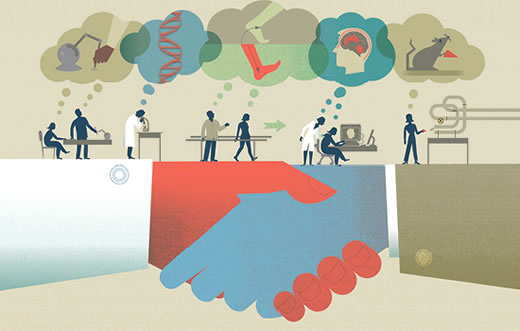Civil engineers have nothing on Emory Doctor of Physical Therapy (DPT) researchers. Investigators have been building bridges that span disciplines, institutions and countries in an effort to improve treatments and outcomes.
DPT researchers have established footings in a myriad of local institutions, including Georgia Institute of Technology, Shepherd Center, Children's Healthcare and the Atlanta VA Medical Center. Emory research bridges stretch as far as Canada and New Zealand.
The research being conducted by this host of collaborators spans the spectrum from basic science at the molecular level to animal models in the lab and from clinical applications at the bedside to outreach in the community.
"We are trying to break down the silos that tend to exist in research," says Randy Trumbower, PT, PhD, assistant professor in the Division of Physical Therapy. "We feel different perspectives and fresh insights can be very helpful, even critical. So we are working hard to build collaborations to connect our research to other disciplines outside physical therapy, to other institutions outside Emory and to other cities, states and countries. Our goal is to expand physical therapy research with the hope of improving the lives of people with a neurological injury."
Emory - Georgia Tech Collaboration
For an example of the type of collaborations taking place, consider the spinal cord rehabilitation research going on at Emory and Georgia Tech.
Trumbower has built ties with many institutions. At Georgia Institute of Technology alone, he is working with investigators in four different areas – neuroscience, physiology, rehabilitation and engineering. And Georgia Tech's Parker H. Petit Institute for Bioengineering & Bioscience provides funding for research Trumbower is doing in his Emory lab on a therapy involving repetitive acute intermittent hypoxia (AIH).
At the Center for Robotics and Intelligent Machines, Trumbower is collaborating with other engineers to develop haptic interfaces (devices that provide tactile feedback and virtual reality) for spinal cord injury rehabilitation research. "Haptic robots allow you to simulate things you would experience in the real world but in the controlled environment of a lab," says Trumbower, who has program faculty appointments in the Department of Biomedical Engineering, Robotics PhD program and the School of Applied Physiology at Georgia Tech. "For example, a haptic robot can create an isolated resistance in one direction or it can produce vibration as if holding a power tool. This novel technology allows researchers an opportunity to get a sense of how the intact or injured nervous system is able to adapt to changes in our environment."
With collaborators in the School of Applied Physiology, Trumbower is looking at mechanisms of motor control in the spinal cord. In the Department of Biomedical Engineering, he is quantifying underlying neuromotor deficits that affect muscle coordination during walking after spinal cord injury.
Other collaborations include the University of Wisconsin, where he is working with the Department of Comparative Bioscience, Neuroscience, and Veterinary Sciences to look at the molecular, cellular and behavioral changes associated with AIH-induced neural plasticity in rats with spinal cord injury.
"My approach in research is to build bridges of collaboration that incorporate a broad range of expertise with a common mission to improve neurologic rehabilitation," says Trumbower.

